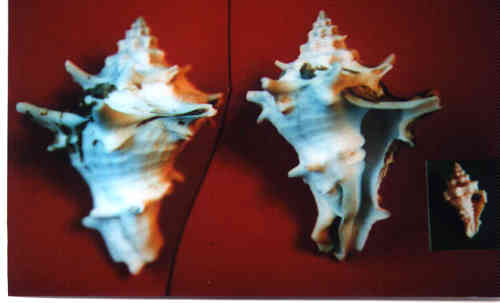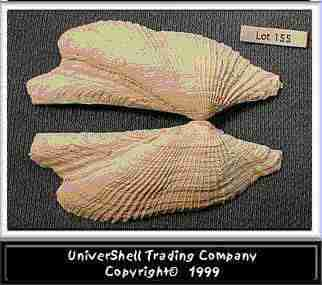
Newsletter of the Shell Club of Sydney
NSW Branch, The Malacological Society of Australasia Limited ACN 067 894 848

The wedding of two of our well-known members
Chris Barnes (Club Secretary) and Karen Wadwell (types sheller articles if you can't)
Turbinellidae
Part 15
By Ulrich Knodel
Vasum stephanti Emerson & Sage, 1988
(The Nautilus 102 (1):36-39, 1988)

"Stephant's Vase Shell" is still a rather unknown species, discovered just ten years ago. The name was given in honour of Capt. A. Stephant who was the first to make specimens of this available.
This species lives off Somalia in greater depths; 183 - 220 metres are reported in literature (the largest one in my collection is reported to be from "roundabout 400m").
The type locality is 13 -16 km east and 80 - 96 km south of Cape Guardafui (Ras Asir), Somalia. Gardafui is a misspelling in the original description.
The size seems to be 90 - 100mm (Paratype 1 is 107.68mm; the largest one of my collection is 91.8mm). Also in my collection is a juvenile shell of 34mm that shows the typical appearance (shape, columellar folds, high erected spire, ribs) but with of course, still weak developed spines; I have got it together with an adult from "190m off southern Somalia".
This species is reported to morphologically resemble Vasum tubiferum from the Philippines but in my opinion, all these thick -shelled spinose Vases look (in the wider sense) a bit similar. Further remarks will be made in the next part of this series where I will discuss the Vase shells in regional order. Interested shellers can ask the editor of this journal for a photocopy of the original description of this species.
Photo below:
Vasum stephanti, Left: "Trawled in about 400m off Cape Guardafui" 91.8mm, back & front.
Right: :From 190m off southern Somalia", 34mm, juvenile.
Wanted: For this study I urgently need all available information about
Vasum lactisfloris Ferrario, 1983.
Marriage in the club
Karen and Chris missed our last meeting because they were on their honeymoon.
They are back and settling into a routine. The only comments so far:
"We had a lovely time at our wedding and a very quiet and peaceful honeymoon on Norfolk Island. Unfortunately there wasn't much scope for shelling. We looked hard to see what shells were there, and hope to give a report."

Chris performs all our club secretarial functions, including the production of minutes of each monthly meeting for the benefit of those that cannot attend all meetings. These are issued in summary form in the
sheller.

Karen, as well as supporting Chris, provides a valuable function for the sheller. Our editor normally only accepts articles in electronic form (disc or email). For hand written or printed articles Karen retypes them as electronic documents ready for the sheller.
By the way the title of this article does not mean Karen is 'in the club
yet', but it doesn't hurt to plant the thought.
Selling (or Buying) shells through the Net
Steve Dean BE(UNSW) IEEE FAICD
They say an Internet year is three months. The technology is changing so quickly the following article is likely to become dated very quickly. It is valid as for 20 Oct 99.
Selling shells via the Net is becoming increasingly popular. For those that are traders, pricing needs to be competitive, or stocks available because the competition is only a few key strokes away. There is the benefit of selling to the whole world rather than just to the local shelling community, so turnover can be higher. For those that specialise in rare expensive shells the Net is also a good medium. It allows you to quickly spread the word about what new treasures you have on offer.
Most of the shell traders on the Net offer their shells for sale (or swap) by one of four methods, Emailed Lists, Web pages with photos and prices, On line Auctions, or On line classifieds and notice boards. Each of these has merit. I will briefly explain the differences below.
Email
The traditional method of selling shells, other than in a retail shop, was to prepare written lists detailing each shell and its price, and for the more expensive shells having photographs available, then mailing these to individuals and clubs worldwide.
Email is very similar. Lists with prices and descriptions are prepared and included within emails that are electronically sent to a mailing list of interested individuals worldwide. Usually the shell lists are in the body of the email rather than as attachments. As a result they are less column formatted than printed lists. (They are sent this way because it is easier and faster for recipients to open them, thus they are more likely to be read. This also corrects for the many different formats and software packages that will receive the lists, as well as MAC - IBM differences)
Photos are usually sent by email on request only so as not to make the original email lists too large.
If the emails are too long and too frequent, people request to be removed from the mailing lists, so most list senders send only updates, specials and new finds. Full lists are emailed only on request.
The benefit of email lists is that they are easy to prepare, easy to send, and most importantly can get new material on sale world wide extremely quickly, as people check their emails often. Because they are sent to a mailing list they get directly to all that are interested worldwide.
(The article in this sheller titled 'Another web trader', is an example of an email list.)
Web Pages
This is like publishing a colour brochure showing the shells you wish to sell at the moment. It is also like having a shop front window display that gets to the whole world. This makes life easier for the buyers as they can see what they are getting. It therefore makes it more likely you will sell faster with increased turnover.
The downside is you have to prepare your web pages site and do the layout work. As shells sell the pages need to be re-done.
The site also needs to be interesting and changed frequently or people will not check it often enough. Most web sites therefore offer other things ranging from regular articles about specific shells to chat forums and electronic bulletin boards to exchange ideas and place classified advertising.
Web sites that attract viewers are similar to magazines containing articles advertising and entertainment. Their advantage is minimal distribution cost.
You can do something a magazine cannot. If you have a web site then as you introduce new batches of shells for sale you can email prospects to let them know it is time to look at your web site again, and what is new. This combining of emails and the web pages provides a powerful selling (and buying) medium.
Web pages allow you to cast your selling net to a far wider audience than your email list, and enables you to subsequently expand your email list.
On Line Auctions
These are becoming extremely popular in many developed parts of the world, and have come into their own over recent months in Australia. While there are general auction web sites, there are also specific sites for shell traders and collectors. The actual auction can be hosted anywhere in the world, and all can participate. As the Net evolves so rapidly I will not list the current shell auction sites. (Use your search facilities).
These are similar to conventional auctions except that interested parties all over the world can bid.
As popularity increases, this may allow traders to command higher prices as retailer margins are bypassed with traders, or anyone else wanting to sell shells, selling direct to consumers.
Listing in on line bulletin boards
Existing shell web sites often have free classifieds/bulletin boards and there are companies that offer on line shop fronts as part of bigger on line shopping malls. These can be economical, but do not highlight your shells for sale. Your own web site with reminder emails to your customer base is the most effective. There is nothing wrong with listing on bulletin boards as well as having your own listings.
The future
Long term is impossible to predict.
Short term there is an industry trend to more sophisticated web pages created dynamically form databases.
These allow purchaser to search specifically for what they want (price, region, shell type etc.) They also allow sellers to update database entries with virtually no computer knowledge. For sellers this means shells can be removed from the advertising as soon as sold, and new ones and specials added immediately.
In the past small businesses such as shell traders have not used database driven pages, because the Java software coding included in the web pages was complex or extremely expensive to have written.
Now with the introduction of ASP dynamic database driven web pages can be available for even the smallest operator.
For the technically minded ASP technology is replacing Java for data base driven web pages because the price for setting up the software in the web pages is so much lower, and data can be kept in well known database formats such as Microsoft Access.
Steve Dean owns one of Sydney's ISPs. This ISP, Easynet, establishes web sites and ASP databases for customers worldwide. It also offers full hosting services.
The purpose of the above article is not to drum up business. It is to help shell traders not using the net to understand the options, and understand what they are missing out on.
If members are interested, further articles could be prepared covering the importance of getting your own domain name, and the pros, cons and risks of credit card transactions on the Net.
Another web trader.
Donald Chan donchan@hkucc.hku.hk
Donald's initial Email:
'Dear shell collector,
My name is Donald Chan. I am a shell dealer living in Hong Kong. I just
completed my first list including most of my murex shells. Please enjoy it.
I can provide images of each shell, please ask. I judge shell very hard and
most of my shells are really high quality. Looking forward to hearing from you soon.
Sincerely, Don
P.S. If you do not want to accept my future list please reply to me. Thanks.
Part of list follows:
Chicoreus brunneus 61.4mm Gem w/o New Caledonia Perfect orange super
fronds. $90
Chicoreus brunneus 59mm Gem w/o New Caledonia Perfect light brown. $30
Chicoreus cervicornis 36.7,40.6mm Gem Australia $8 each
Chicoreus cornucervi 97.2mm Gem w/o Australia Long dark recurved spines
$55
Chicoreus corrugatus 63mm Gem w/o Israel Exceptional large. World
Record. $350
Chicoreus corrugatus 50mm Gem w/o Israel Exceptional dark pink fronds.
$190
Here is his next Email:
Here are some outstanding leucodon just live taken last week. They are really fresh and outstanding so I am posting them ahead of my regular list.
Part of his list follows:
Cypraea leucodon 91mm Gem Philippines. Cebu. OUTSTANDING. Super clear fully spots. Giant. Twice than normal clear spotting cover all of the dorsum. Direct from fisherman. Very fresh just collected last week. Cowries
collectors dream. Very hard to get this quality. $2300
Cypraea leucodon 78.8mm Gem Philippines. Cebu. Super dark chocolate
brown color with large clear solid white spots. Super Gem quality. Very similar to the Thailand leucodon. Direct from fisherman. Very fresh just collected last week. Another outstanding leucodon. $1550
Cypraea leucodon 78.5mm Gem Philippines. Cebu. Super Gem quality.
Direct from fisherman. Very fresh just collected last week together with
the other leucodon. Same habitat but small spots look like Thailand
leucodon. The dorsal line is almost hidden. Super dark margin. Very
different from normal one. Good price for this quality. $980
Cypraea katsuae 18mm Gem Philippines. Balut Island. Super dark Gem. Approaching to vicdani but it is a real katsuae. Very interesting. $380
Cypraea langfordi 52.1mm Gem Philippines. Super Gem. Dark color. Very beautiful. Good price. $220
Cypraea porteri 46.1mm F+++ Philippines. Small defect only. Good
Price. $70
Cypraea hirasei 50mm+ Gem Philippines. Super dark pattern cover
all of the dorsum. Outstanding quality with this pattern. $590
Conus excelsus 73mm F+ Philippines. Lip filed and proto worn. But
good size and good price for this rare species. $100
Web update:
The Univershell trading company web site now has a number of new things including a basic reference on fossil shells focusing on Florida:

Fossil Arca wagneriana
|





